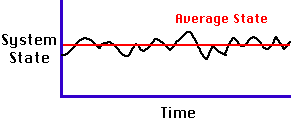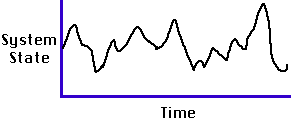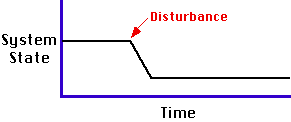Geog 1190 (II)
Geography 1190/1180
Part II
System Feedback and Equilibrium
If you've already taken Geography, you probably already know this. But for the purposes of being thorough, here we go!!
Last time we talked about systems. In open systems, there are inputs and outputs. today, we're gonna talk about how these inputs and outputs affect the system.
Think about our digestive system - food goes in, poop comes out, but we (the system) absorb the nutrients in the food and grow. The nutrient intake is called 'feedback' and it happens in most open systems.
There are two kinds of feedbacks: Positive and Negative. Don't associate negative feedback with that bad review on your Twilight Fanfiction. Positive and Negative feedback have nothing to do with good or bad. I will explain.
Positive Feedback is like a catalyst, it encourages response within the system. When it enters the system, it stimulates the growth of the system and accelerates changes, like putting horse steroids in your baby's food.
If unchecked (whatever that means), a system could have too much positive feedback and have a 'runaway condition' or a 'snowball effect.' Think of a fire - the hotter the fire is, the faster the surrounding leaves are going to dry up and catch, making a bigger, hotter fire, and so on.
If the growth remains unchecked (like, no firemen) a critical limit or a threshold is eventually going to be reached (the world engulfed in flames) leading to instability and a breakdown of the system (no more things to burn = no more fire).
Another good example is GLOBAL WARMING (dun dun dunnn) - as we put greenhouse gasses into the atmosphere, it creates a hole in the ozone layer that lets solar radiation in. This melts the ice caps, which are needed to reflect more solar radiation. And so on.
Negative Feedback isn't bad. Think of it as a subtraction sign. (+ive and -ive). It diminishes the original change, discourages response within the system and decreases growth. Basically, it's mother natures self-regulation tool.
When you binged this Christmas, you got fat. Looking at the weigh scale made you realize that the changes in your system weren't good. So you put your fat ass on a treadmill. When you looked at the scale, you put negative feedback into your system (not bad, rather, averse to change) and your system adjusted.
When positive and negative feedback are pumped into the system, when they work together it's called an equilibrium.
A steady-state equilibrium looks like this:

The system fluctuates, but overall it maintains a basic default position. An example of this would be the temperature outside. In the winter, it's colder than average, in the summer, it is hotter than average. The basic average remains the same. Dreary.
Compare that to a dynamic equilibrium. A dynamic equilibrium is where the system fluctuates around a steady average but exhibits a trend over time:

You can't really draw a straight line through it, so it's a wacky, sort of fucked up equilibrium. What this graph doesn't show is that the black line on this chart is probably the average of a billion tiny fluctuations. So imagine if the red line on the first graph was now the black line. That's a lot of crazy change, but it's okay because it takes place over a long period of time.
When it isn't okay anymore, we get a metastable equilibrium. This is an abrupt change from one to another.

The 'disturbance' in red is usually a result of too much positive energy disrupting the system (like the fire example I talked about). Because of this, the disturbance causes a system breakdown, fuckup or some other such, and it has to either adapt or die. So it adapts pretty damn quick and we get a new equilibrium, that is the metastable equilibrium.
Let's move on to the Earth. When talking about the Earth, we're always talking about one or more spheres. These spheres are
- The Atmosphere
- The Lithosphere
- The Hydrosphere
- The Biosphere
The Lithosphere is the 'crust' of the Earth. It's the brittle, solid outer layer that's always moving around etc. It's about 100km thick.
The Hydrosphere is a way of conceptualizing all water on the Earth. Below ground, above ground, frozen, boiling. All of it.
The Biosphere is basically all living matter. Plants, animals, child molesters. Everything.
Some scientists think that there is a fifth sphere, the AWESOMESPHERE Cryosphere, which pertains to ice. But fuck that, ice is water, so most scientists lump it in with the Hydrosphere.
ARE YOU READY TO GET PUNCHED IN THE FACE BY KNOWLEDGE?!?!
The Earth is not round. No, it is not round, which is to say that it isn't a complete sphere. It is a Geoid, which basically says "Earth is Earth-shaped." Because the Earth spins around so quickly (counter-clockwise if you're looking at the North Pole) it has developed a sort of bulge at the equator - it's been stretched out from flying around so much! That's called Centrafugal force, people!
Also, the Greeks figured out that the Earth was round(ish) and apparently forgot long before the Dark Ages. If you Wikipedia Eratosthenes, you'll know how he figured it out. Holy shit, eh?
SO! He invented latitude (parallels) and longitude (meridians) and that's how we 'Georeference' today, which basically means find-shit-on-a-map.
Earth's 'graticule' is based on Earth's rotation around the central axis.
Latitudes go up and down from the equator, from 0 - 90 degrees. Longitudes are the angular distance from a relative point - like the stripes on a beach ball.
I don't know why the following is so, but we divide degrees into 'minutes.' 1 degree is 60 'minutes' which is divided into 60 'seconds'
1 'minute' of latitude, on the equator is equal to one nautical mile (1.8km). When you get closer to the poles, it changes because, like, the Earth gets smaller.
Longitudes are relative to the "Prime Meridian" which goes through Greenwich. Hence, Greenwich Mean Time (GMT) begins at the Prime Meridian and the other latitudes are other time zones. (see the comments for more info)
[side note: the GMT has been secretly replaced by UTC which uses atomic clocks and is much more effective, but keeps the same time zones.]
That's all for today.